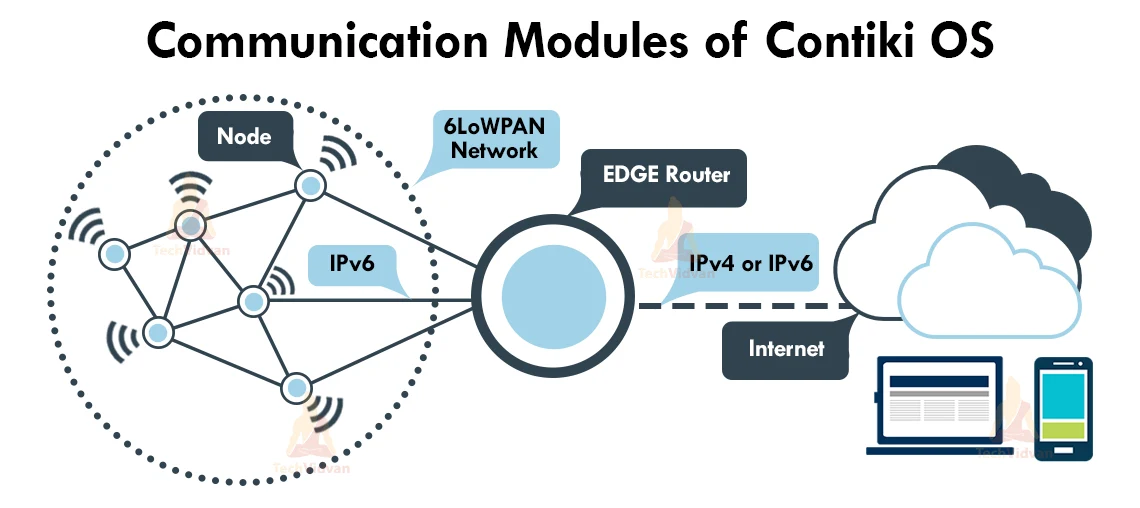Contiki OS – Open Source OS for IoT
Contiki is an open source operating system designed specifically for the internet of things devices such as low-power microcontrollers, wireless sensors and networking devices. Contiki is a portable operating system with multi-tasking features. It has communication components such as uIP and 6LoWPAN which makes it different from the other operating systems. Its special functionality such as lightweight and flexible for IoT devices makes Contiki a highly popular option.
Contiki runs on a smaller amount of kilobytes and can adjust an entire operating system. It connects tiny microcontrollers to the internet. It is a powerful source for building highly complete wireless systems.
Contiki communication components
1. uIP – uip is also known as micro IP. The low power iot devices do not have the capacity to implement the TCP/IP protocols due to very limited resources. MicroIP contains minimized components that are essential components for TCP/IP stack, it is meant for tine 8 and 16 bit microcontrollers.
2. uIPv6: It provides IPv6 networking. The uIPv6 offers new internet communication capacities to the Contiki. It provides a larger address space. It supports IoT devices such as sensors.
3. Rime: The rime communication stack offers a set of lightweight communication primitives that are in use by sensors ideally. This networking is designed for low cost wireless systems.
4. 6LoWPAN: It was designed to apply the internet protocol to low power internet of things devices. Low power devices with lesser processing capabilities participate in IoT via 6LoWPAN. It has ideal characteristics that dominate the market such as smart homes, sensors and actuators.
5. CoAP: CoAP is a web transfer protocol. We can utilize it with constrained nodes and constrained networks in the Internet of things. Traditional protocols are heavy for memory constrained devices and thus CoAP became a necessity.
6. RPL: IPv6 routing protocol designed for lossy networks and low-power networks.
Functions of IoT Contiki
1. Memory and process management
Contiki supports the standard c programming memory allocation known as malloc(). It helps in memory block allocation. “Protothreads’ ‘ supports the requirements of a low system. They are in the C language and reduce the overhead of multithreading programming.
2. Communication management
Contiki upholds the IPv6 and IPV4 stack implementations. These primitives include the TCP, UD and HTTP protocols. The Contiki operating systems also empower low-power implementations such as the 6LoWPAN.
3. File system management
Every IoT device may not have a large and persistent memory storage such as the flashes. The coffee file system by Contiki empowers such devices. It is for devices with an external flash memory chip
Dynamic module loading
In order to make programming easier, Contiki supports dynamic loading of programming modules. There are two programming interfaces to load a program- with the help of an ELF(executable linkable format) and the native executable format.
The dynamic module can be written in the flash memory using the coffee file system.
Cooja network simulator
The contiki systems contain a network stimulator known as Cooja network simulator. It stimulates networks on nodes that support Contiki. The contiki programming model has prototypes to run a small memory system remotely. Prototypes are memory efficient programs that include multithreading to achieve low memory overhead.
Application of IoT Contiki OS
Contiki OS includes various applications that are part of the OS. Such as lightweight browser, lightweight web servers, shell, calculators, telnet to manage devices remotely, email clients and user, vnc viewer and ftp.
For developing an application, developers can look for tools such as the cooja simulator. We can measure the power of various applications in contiki that can help developers to make power sensitive applications.
The software package also includes a UNIX style shell for OS interface and debugging.
Summary
So, in this article we learnt about the contiki operating system and a few of its applications, functionality. We learn about the cooja network simulator, dynamic module loading and the contiki communication components. We hope our explanation was easy to understand.

